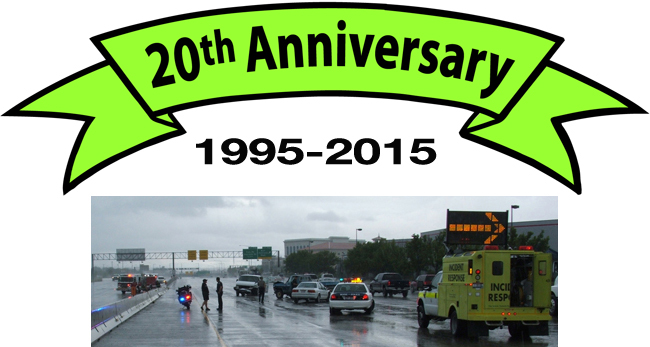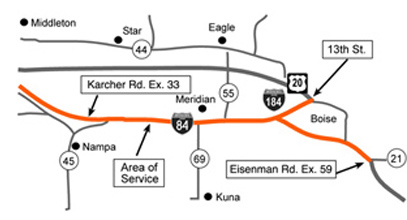

Road Warriors or Road Angels: “Big yellow trucks” beloved
by police and commuters alike
Most people know the story: a small plane makes an emergency landing on the freeway in east Boise Oct. 13. The story made national news.
On Sept. 28, a semi struck a support column on the Mayfield Overpass in east Boise. Again, even the media outside of the Treasure Valley took notice.
In the case of the freeway landing, the need was to initiate the move of traffic in order to facilitate removal of the plane. In the case of the overpass strike, the need was to secure the overpass while bridge investigators verified the extent of the damage.
In both cases, the Idaho Transportation Department’s Incident Response team was one of the primary units to accomplish that safety goal.
Ensuring the safety of the scene, and providing an alert to drivers of impending traffic changes, are two of our main functions," said ITD Incident Response driver Nick Jones, who has been with the program since Feb. 2004. "We change the dynamics of traffic flow."
It can be argued that driving in the Treasure Valley has only gotten more challenging in the last two decades. The number of vehicles on I-84 between Nampa and Boise has doubled. The price of gas has doubled or tripled, depending on the month. The price of car insurance has skyrocketed as well.
Incident Response is an initiative created to combat those unfortunate realities. It also has benefited both law enforcement and the driving public for the last 20 years. ITD launched the Incident Response pilot program in November 1995.
Legions of thankful drivers, law enforcement officers, and emergency responders look back fondly.
"The locals really know who we are," said Jones. "I've never seen anyone who wasn't really glad to see us."
The program was created to improve safety and facilitate traffic flow on the interstates near Boise. The Incident Response team provides a valuable service to commuters by reducing congestion through responding to crashes, disabled vehicles and other issues that impede traffic, reducing emissions from idling vehicles, and reducing secondary crashes that occur when traffic backs up.
The Incident Response technicians also support emergency responders, such as law enforcement and ambulance staff. They provide updates to the state's 511 Traveler Service through the State Communications Center. On the three major summer holidays (Memorial Day, Fourth of July and Labor Day), the service will send trucks up Idaho 55 between Horseshoe Bend Hill and Cougar Mountain Lodge to reduce traffic congestion.
The Incident Response unit is vital to traffic flow and safety, said Idaho State Police Capt. William Gardiner.
"Because of the dangers of the job, troopers are frequently exposed to high traffic volumes and vulnerable to hazardous drivers," Gardiner said. "While investigating crashes or conducting other police business, the extra measure of safety provided by ITD's Incident Response gives every trooper on scene an added level of safety and protection."
Equal needs
Twenty years ago, about 50,000 vehicles used the road between Nampa and Boise. Today, that number has swelled to approximately 100,000. The price of gasoline was about $1.10 back then. Today, it fluctuates most often between $3-$4 per gallon, meaning the value of free-flowing traffic has never been higher.
At some time, almost all drivers have experienced a flat tire, needed a push in the right direction, run out of gas, have had an engine overheat, or were involved in or are on the scene of a fender-bender. The Incident Response team will change that flat, jump-start that car, refill that radiator, provide a gallon of gas to that stranded motorist, or offer use of a cell phone. Incident Response does not tow, but will push or pull a vehicle to a safer spot on the highway shoulder.
Other agencies — fire, police, ambulance, humane society, fish and game, counties, cities, sheriffs, towing — typically approach us with a handshake and 'thank you,'" Jones said.
Speedy service
The service averages about 17 minutes per incident, from the time Incident Response is dispatched to the scene by ISP until the assistance has been given
The Incident Response team routinely puts 120,000 miles or more per year on the odometer of each truck. The team consists of three drivers and three trucks.
Any incident that clogs the roadway has the potential to create secondary crashes. But the quicker the original incident is cleared, the less time motorists and response personnel are exposed to hazards and the possibility of secondary collisions.
For each minute a crash is not cleared, the chances of a secondary crash increase by about three percent. By this measure, each half hour a crash is not cleared almost doubles the chances of another crash.
"We try to assist in all incident details — from first contact to ensuring scene safety, requesting or cancelling resources, relaying reports to the drivers involved, assisting fire, ambulance and towing — to create a seamless force that efficiently clears whatever incident is affecting our roads," Jones explained.
"There are times when we are the only agency involved," he added. "Our flexibility and willingness do not go unnoticed. Local agencies know that we will do whatever we can to aid anyone at any time."
Beyond the ordinary
Along with the routine calls, Incident Response has been on some unusual calls over the years. The crew has removed a Christmas tree from the eastbound Connector, as well as water heaters, mattresses and other road hazards. They've herded animals -- horses and dogs, mostly -- off the road, recovered wallets and cell phones, assisted ISP in planning and providing traffic control for a presidential motorcade and two vice-presidential visits, and escorted the Special Olympics buses from Sun Valley.
In 2007, they found a wedding dress in the westbound lanes on I-84 between Nampa and Meridian, with the message Cherished Memories written on the box. They eventually reunited the dress with its thankful owner. They've also rescued pets perched on the barrier between fast-moving traffic, cleaned up fuel spills with inflatable plastic kiddie swimming pools, and saved a wounded hawk from the side of the road and delivered it to a raptor rehab center. They also rescued a four-wheeled car with five flat tires (the four on the vehicle, plus the spare). There was even a call-out for a severed hand along the shoulder of the interstate near Broadway in November 2010, that was found to be someone sleeping near the guardrail. The hand was attached to the body after all – it was just the only part visible from the roadway.
They have investigated bomb threats, put out fires, blocked the freeway so Life Flight could transport victims to the local hospital, chased cows off the road and then repaired the hole in the fence the animals came through. They have responding to roadside wildfires, saved a dog with a dislocated/broken hip and took it to an animal hospital, and cleaned up spilled cow entrails so slick they had to be sprayed off the road with high-powered water hoses from the fire department.
Most recently, they transported a dog from a vehicle that was about to be towed.  The dog is pictured below.
The dog is pictured below.
During peak commuting hours, Monday through Friday, the Incident Response team patrols 30 miles from the Franklin (milepost 29) to Eisenman (milepost 59) interchanges, and the Connector from the Flying Wye to 13th Street. See map, above.
Worth the cost
The service costs about $250,000 per year, a number that reflects fuel and operating costs for the trucks and the salary of the drivers, and is primarily paid for by registration fees and money from fuel taxes. There is a significant economic benefit to reducing traffic impediments. It's been estimated that in southwest Idaho, a half-hour delay in an urban setting equates to about $30,000 in lost work productivity, secondary crashes, increased fuel consumption and Increased vehicle emissions. That means just more than four hours worth of congestion or impediments are reduced during a calendar year, the service has paid for itself. They do that each and every month.
"As the years have gone by and our trust has grown, so has our scope," Jones said. "If we respond first, our initial assessment of the scene is regarded as factual. This is a far cry from just coming out and putting up cones."
Nationally, the Transportation Institute estimated the cost of congestion at $269 million in the Boise metro area.
As traffic volumes have increased, the number of incidents has correspondingly grown. Traffic is projected to continue to skyrocket in the Treasure Valley (The planning organization of southwest Idaho estimates Ada and Canyon county populations to grow to 1.3 million residents by 2040), and the Incident Response team will continue to provide expected - and unexpected - service to commuters.
"The ITD Incident Response program has been a monumental success," said ISP's Gardiner. "ISP Troopers have become accustomed to working hand-in-hand with these dedicated ITD employees in the interest of traffic safety.
"They are quick, reliable and always go out of their way to assist whenever called upon.
"The program shows great interagency cooperation as both agencies attempt to reach a common goal. It has become an integral part of traffic highway safety in Idaho."
Published 11-06-15